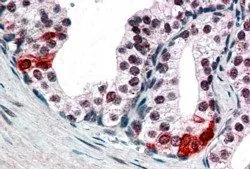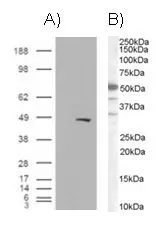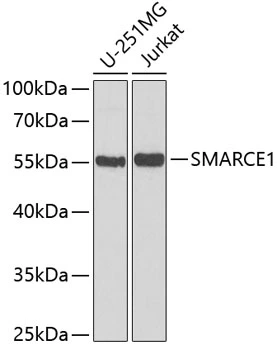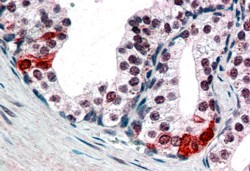
IHC-P analysis of human prostate using GTX89755 BAF57 antibody, C-term. It shows nuclear staining in secretory epithelial cells. Dilution : 3-5microg/ml
BAF57 antibody, C-term
GTX89755
ApplicationsWestern Blot, ImmunoHistoChemistry, ImmunoHistoChemistry Paraffin
Product group Antibodies
TargetSMARCE1
Overview
- SupplierGeneTex
- Product NameBAF57 antibody, C-term
- Delivery Days Customer9
- Application Supplier NoteWB: 0.2-0.6microg/ml. IHC-P: 3-5microg/ml. *Optimal dilutions/concentrations should be determined by the researcher.Not tested in other applications.
- ApplicationsWestern Blot, ImmunoHistoChemistry, ImmunoHistoChemistry Paraffin
- CertificationResearch Use Only
- ClonalityPolyclonal
- Concentration0.50 mg/ml
- ConjugateUnconjugated
- Gene ID6605
- Target nameSMARCE1
- Target descriptionSWI/SNF related BAF chromatin remodeling complex subunit E1
- Target synonymsBAF57, CSS5, SWI/SNF-related matrix-associated actin-dependent regulator of chromatin subfamily E member 1, BRG1-associated factor 57, SWI/SNF related, matrix associated, actin dependent regulator of chromatin, subfamily e, member 1, SWI/SNF-related matrix-associated actin-dependent regulator of chromatin e1, chromatin remodeling complex BRG1-associated factor 57
- HostGoat
- IsotypeIgG
- Protein IDQ969G3
- Protein NameSWI/SNF-related matrix-associated actin-dependent regulator of chromatin subfamily E member 1
- Scientific DescriptionThe protein encoded by this gene is part of the large ATP-dependent chromatin remodeling complex SWI/SNF, which is required for transcriptional activation of genes normally repressed by chromatin. The encoded protein, either alone or when in the SWI/SNF complex, can bind to 4-way junction DNA, which is thought to mimic the topology of DNA as it enters or exits the nucleosome. The protein contains a DNA-binding HMG domain, but disruption of this domain does not abolish the DNA-binding or nucleosome-displacement activities of the SWI/SNF complex. Unlike most of the SWI/SNF complex proteins, this protein has no yeast counterpart. [provided by RefSeq, Jul 2008]
- Storage Instruction-20°C or -80°C,2°C to 8°C
- UNSPSC12352203








